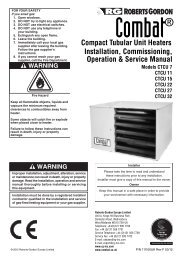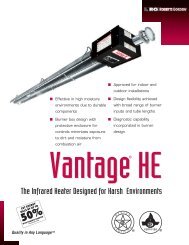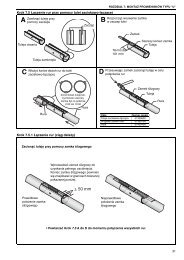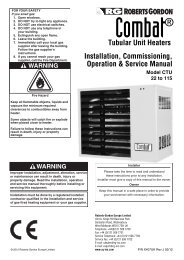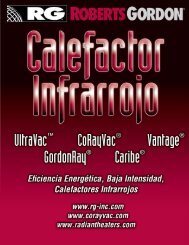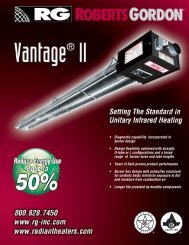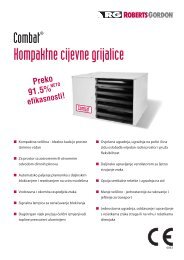Vantage Modulating - Roberts Gordon
Vantage Modulating - Roberts Gordon
Vantage Modulating - Roberts Gordon
Create successful ePaper yourself
Turn your PDF publications into a flip-book with our unique Google optimized e-Paper software.
SECTION 9: GAS PIPING<br />
SECTION 9: GAS PIPING<br />
WARNING<br />
Fire Hazard<br />
Tighten gas hose fittings to connect gas<br />
supply according to Figure 21.<br />
Gas hose can crack when twisted.<br />
Gas hose moves during normal operation.<br />
Use only 36" (91 cm) long connector of 1/2" or<br />
3/4" nominal ID.<br />
Connector supplied with heater for U.S.<br />
models (not with Canadian models).<br />
Failure to follow these instructions can result<br />
in death, injury or property damage.<br />
WARNING<br />
There is an expansion of the tube with each firing<br />
cycle. This will cause the burner to move with respect<br />
to the gas line. This can cause a gas leak resulting in<br />
an unsafe condition if the gas connection is not made<br />
in strict accordance with Figure 21.<br />
Meter and service must be large enough to handle all<br />
the burners being installed plus any other connected<br />
load. The gas line which feeds the system must be<br />
large enough to supply the required gas with a<br />
maximum pressure drop of 1/2" wc When gas piping<br />
is not included in the layout drawing, the local gas<br />
supplier will usually help in planning the gas piping.<br />
Gas lines must meet applicable codes:<br />
United States: The Flexible Stainless Steel Gas<br />
Hose (US models) supplied with the heater is<br />
certified per the Standard for Connectors for Gas<br />
Appliances, ANSI Z21.24/CSA 6.10 - latest revision.<br />
Canada: The Rubber Type 1 Gas Hose (Canadian<br />
models) optional with the heater is certified as being<br />
in compliance with the Standard for Elastomeric<br />
Composite Hose and Hose Couplings for Conducting<br />
Propane and Natural Gas, CAN/CGA 8.1 - Latest<br />
revision.<br />
• Check the pipe and tubing ends for leaks<br />
before placing heating equipment into service.<br />
When checking for gas leaks, use a soap<br />
and water solution; never use an open flame.<br />
Explosion Hazard<br />
Leak test all components of gas piping<br />
before operation.<br />
Gas can leak if piping is not installed<br />
properly.<br />
Do not high pressure test gas piping with<br />
heater connected.<br />
Failure to follow these instructions can result<br />
in death, injury or property damage.<br />
Install the gas hose as shown in Figure 21. The gas<br />
hose accommodates expansion of the heating<br />
system and allows for easy installation and service of<br />
the burner. Before connecting the burners to the<br />
supply system, verify that all high pressure testing of<br />
the gas piping has been completed.<br />
37 of 71



